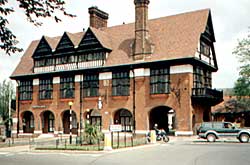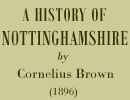< Previous | Contents | Next >
The town was first incorporated in the reign of Edward VI. (1549), when the chief dignitary was called the Alderman. A new charter was granted by Charles I. in 1625, since which time a Mayor has been elected every year. In 1661 the borough sent two representatives to the first Parliament of Charles II., and continued to do so till the last Redistribution Act, when this privilege was taken away and Newark was made the centre of a Parliamentary division returning one member.

A panorama of Newark-on-Trent from 1676.
About the time of the Reform Bill, the town was the scene of some exciting Parliamentary contests. Mr. Gladstone in 1832 found his first seat in Parliament as representative for Newark, nominated by the Tory Duke of Newcastle, who wielded at the time great political influence in the borough. His opponent was Serjeant Wilde, afterwards Baron Truro, Lord Chancellor of England. Another candidate for Newark, who rose to be Lord Chancellor, was Mr. Thesiger, and the contest between him and Serjeant Wilde in 1839, when the latter was made Solicitor-General, is one of the most memorable in the electioneering history of Newark. Serjeant Wilde was returned by the small majority of nine votes, and the event has ever since been known as the 'number nine election. Newark, with its 15,000 inhabitants, is a model town of its size. A capacious and well-proportioned market-place is flanked on one side by the handsome parish church, whose graceful spire and chaste architecture are the delight of every beholder. A handsome free library, given by Sir William Gilstrap, Bart., stands on ground which was once within the precincts of thecastle, and surrounding this is a beautiful public garden designed and planted out of funds raised by subscription, and opened in 1888. On the opposite side of the Castle Hill is an extensive building erected by the late Viscountess Ossington (who was the widow of Speaker Denison, and resided near Newark) as a temperance refreshment house. It is called the Ossington Coffee Tavern, and is, perhaps, one of the most unique establishments of its kind in England.

Ossington Coffee Palace, built in 1882 (A. Nicholson, 1995).
From the time that the stage coaches crossed each other's courses as they bounded along the broad road from Lincoln to Nottingham, or swept along the grand highway, called the Great North Road, running from London to York, to these days of steam and electricity when the smoking expresses of the Great Northern rush from the Metropolis on their direct journey to the northernly points in Caledonia, Newark has always been familiar to the traveller: long may the good old town continue to show its hospitality to strangers, reminding them by its ancient buildings of the history of the past, and by its elegant modern structures of the prosperity and munificence of the nineteenth century!
